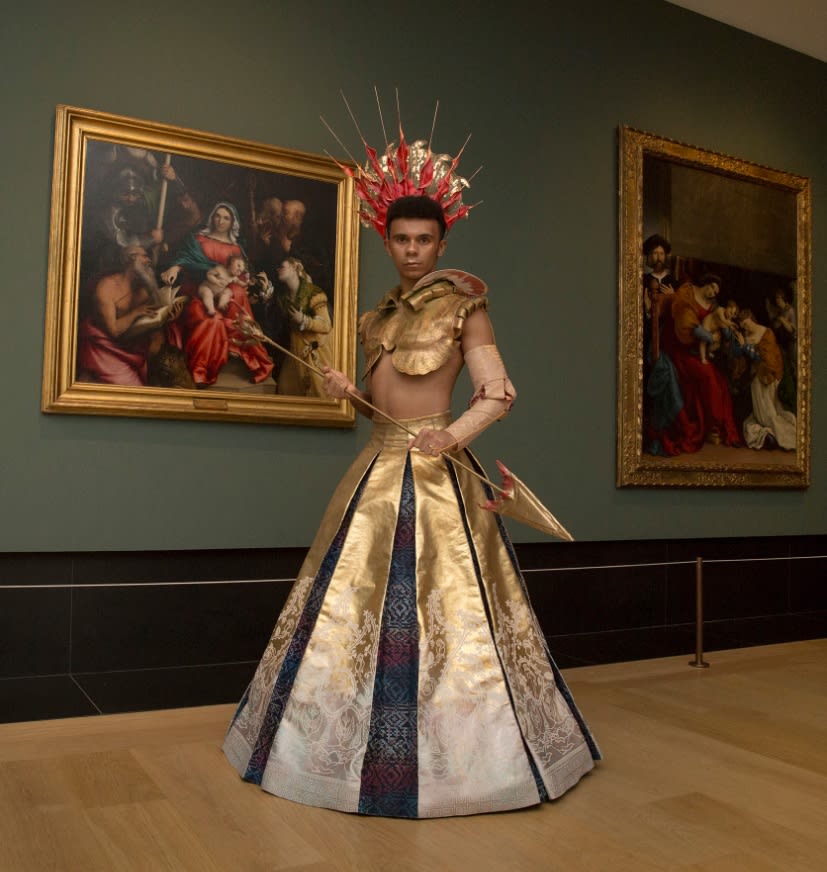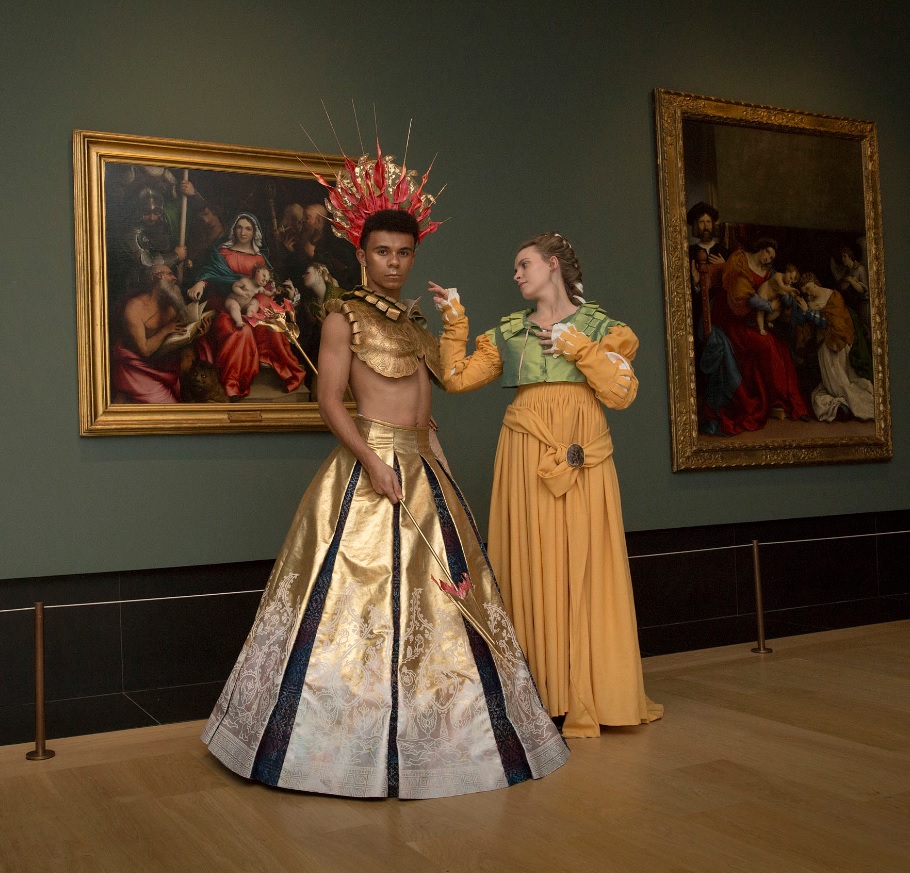Our Costume students brought the subjects of Italian Renaissance painter Lorenzo Lotto’s portraits to life in a special event at the National Gallery on Friday 7 December.
Taking inspiration from the exhibition of Lotto’s portraits currently showing at the gallery, BA Costume Design and BA Costume Interpretation (now BA Costume for Theatre and Screen) students from Wimbledon, in collaboration with The Academy of Live and Recorded Arts (ALRA), presented an immersive, costumed performance in a series of live tableaux, using the original portraits as backdrops.
The Costume Design students responded to the artefacts in the portraits to create dramatic and contemporary interpretations of the Renaissance themes, and Costume Interpretation students responded to the historical dress, detailing and silhouette within the pictures to create beautifully constructed and embellished realisations of the featured garments.
We spoke to Eve Oakley, a Costume Design student, and Samuel Thompson, who studies Costume Interpretation, who both made work responding to the same Lotto portrait, about their experience of working on the project and the similarities and differences in their approach to creating their costumes.
How did you come to work on the costume that you presented? Were you able to choose the portrait to draw inspiration from yourselves?
EO: We were given the choice of paintings in the exhibition catalogue, and from that we picked a character on which to base our research and design. Design students and Interpretation students were able to pick the same characters, because we knew the end results would be entirely different. The painting I chose was not a portrait but a religious work, ‘The Mystical Marriage of St Catherine and Saints’ painted in 1524.
ST: The Costume Interpretation pathway were challenged to create an accurate replica of our chosen subject’s costume. My partner who I worked on the costume with, fellow Costume Interpretation student Beth Gale, and I researched artworks from the time to find examples of the shape of garments from that time period to fill in the gaps from what could not be distinguished from the original portrait.

What were your initial reactions to the portrait and the story behind it?
EO: In the centre of ‘The Mystical Marriage of St Catherine and Saints’ is the Virgin Mary, with the infant Jesus seated on her lap and around her are Saints Jerome, George, Sebastian, Nicolas of Myra, Anthony the Abbot and Catherine of Alexandria. I was initially drawn to the painting because the figure of Catherine really stood out to me. She is positioned slightly forward in the picture and bathed in the same divine light that illuminates the Virgin Mary. Interestingly, she is also dressed in contemporary Renaissance clothing, by contrast to Mary and the other saints, who are largely dressed in more biblical robes. The prominence of Catherine’s eye-catching yellow dress and green partlet really drew me to the character. I felt that the clothing was very significant in Lotto’s depiction of her.
ST: The National Gallery gave us a catalogue in which we could choose a portrait. Each one had an essay or text to explain some symbolism from the paintings that we could use for further research. My partner and I were drawn to the brightness of St Catherine’s yellow dress and the trials and tribulations of her life.
Could you talk about the research that you did to come up with your concepts?
ST: We researched illumination artworks, historical costumes and other artworks from the time coupled with the knowledge we had gathered from our tutors.
EO: I began by researching the history of what is known about the real St Catherine of Alexandria. I looked at accounts of her life and compared this with the way she is depicted in art history. I found that very little about her life is reflected in paintings of her, she is associated only with the Catherine wheel and the palm leaf, a common symbol of martyred saints. In her life, Catherine was a powerful spokesperson for her faith, converting hundreds of people to Christianity, but she defied authorities and was eventually beheaded for refusing to renounce her beliefs. By contrast I found that throughout art history she had been largely reduced to a symbol of female beauty, youth, purity and devotion. She was also depicted as white, often very pale with blond hair, with no reference made to her Egyptian heritage and culture.
I directed my research to build an image of how St Catherine might have appeared in a parallel universe. My research covered her Egyptian background and I studied how they depicted warriors, strong willed characters, as well as women. I looked into the torture and martyrdoms of saints and how this was represented in art. The depiction of blood and wounds as jewel-like against divine flesh inspired the creation of the beaded sleeve and standing collar piece. Motifs on the skirt were taken from Medieval Egyptian Coptic art, combined with symbols of both Catherine and the artefacts she is depicted with in the painting; pearls, roses, and a wedding ring. The striking green partlet worn in Lotto’s painting was reinterpreted as a breastplate in the shape of wings, which I carved from leather. This idea was taken from the crossed leather band chest armour worn by Egyptian leaders in battle.

Can you talk a bit about the different stages of working on this project?
EO: The first stage of the collaboration in this project took the form of an audition day, held by ALRA drama school, where we were given the opportunity to choose a performer to work with on the project. The performers for the Design pathway costumes were chosen in a blind casting, so race and gender did not bias the casting. Many designers had created a costume that looked a lot different from the appearance of the original garments in the paintings, so were open to working with performers who could embody the characters within the paintings, without needing to necessarily look like them.
This was our first opportunity to discuss with our performer about our interpretation of the character. I had an initial design to show Milo, my performer, and it was really good to get his feedback on it. My initial concept then went through an extensive redesign process, whereupon I took apart every element that I had designed and reimagined and refined it to create a more polished piece that considered the personality that my performer brought to the role. We also had to consider both the comfort and the physicality of our performer because they were required to move and sing in the costumes, so the garments could not be too restrictive or cumbersome.
ST: This project took on several stages in the making process, first with researching the shape to create the pattern for the garment and discussing this with our tutor. We completed several toiles and examples of cutting on the stand to create 3D mock-ups of the garment before cutting the final piece. We had the opportunity for two fittings to see how the garment was worn by Katie (ALRA actor) to achieve the desired effect mimicking the original painting.
What were the major challenges that you experienced on this project and how did you address them?
EO: I would say one of the biggest challenges in this project was time management. This was just one of several projects we were juggling at the time, and because this project was extracurricular it meant that there was limited timetabled time to work on it. The challenge of communication with the ALRA students also had to be overcome, as we were limited in terms of time for fittings and to be able to work with our performer on the movement and physicality of the costume.
ST: The most challenging aspects of this project for me were working out the technicalities of creating some elements of the costume in 3D. The sleeves of our dress were complex with many elements; slashing, pinking, the puffed sleeve head, gathering, panes and the voluminous under-sleeve. I had to figure out how to create a sleeve with these elements while working around the limitations of our fabric including how much it frayed and its weight.

What did this project teach you?
ST: Experimentation is key to finding the best way around a problem. Trial as much as you can but don’t be afraid to go for it and trust your ability to improvise!
EO: This project taught me a huge amount in terms of working with a performer, and in a site-specific location. The needs and requirements of the gallery presented challenges that were sometimes unexpected, as we are used to working in theatres, or on film sets.
It was hugely exciting to work with such an important and established organisation and it allowed great publicity for our work. It was also a very different approach to be working from a painting rather than a script or text when designing for a character. This allowed a lot of freedom for experimentation in the design process, and I was able to work with a wide range of challenging materials and techniques to create a piece that was both extreme in terms of scale and technical detail.
‘Lorenzo Lotto: Portraits’ runs until 10 February 2019 at the National Gallery, Trafalgar Square and admission is free.
Learn more about studying BA Costume for Theatre and Screen at Wimbledon College of Arts.

